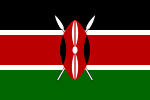| Part of a series on the |
| Culture of Kenya |
|---|
 |
| Cuisine |
- Marakwet is also a district in Kenya, see Marakwet District
The Marakwet are one of the groups forming the ethnolinguistic Kalenjin community of Kenya, they speak the Markweta language. The Marakwet live in five territorial sections namely Almoo, Cherangany (Sengwer or Kimaala), Endoow, Sombirir (Borokot) and Markweta (the dialect giving rise to the common name). Cutting across these territorial groups are a number of clans to which each Marakwet belongs. There were 119,969 Marakwet people in 2019.[1]
Most Marakwet today live in the Elgeyo-Marakwet County, a notably beautiful and picturesque part of Kenya. It is bounded to the east by the Kerio River at 1000 m above sea level, which runs through a small branch of the Great Rift Valley. To the west it includes almost the entire Cherang’any hills which rise to 3300 m above sea level west of the Marakwet escarpment. Significant populations of individuals of Marakwet heritage are also resident in the Trans Nzoia, and Uasin Gishu counties, as well as in other towns in Kenya. Others have moved to live in places as far away as Australia, Southern Africa, the Middle East, and United States.
A large majority of Marakwet lead a simple rural life characterized by mixed small scale farming. They grow mostly maize, potatoes, beans and vegetables in the highlands. Those who live along the escarpment and the Kerio Valley mainly keep goats and zebu cows. They also grow millet, sorghum, cassava, vegetables and fruits, mostly mangoes and oranges. There is a sophisticated pre-historic irrigation furrow system that supports this crop cultivation along the Kerio Valley that is thought to be over 500 years old.[clarification needed]
Some of the greatest long distance and especially steeplechase runners in the world have come from amongst these people. A notable example is Moses Kiptanui, the first man to run a sub-eight in steeplechase.
- ^ "2019 Kenya Population and Housing Census Volume IV: Distribution of Population by Socio-Economic Characteristics". Kenya National Bureau of Statistics. Retrieved 24 March 2020.
